Dragon’s Comeback Mission Ends with successful Splashdown in the Pacific
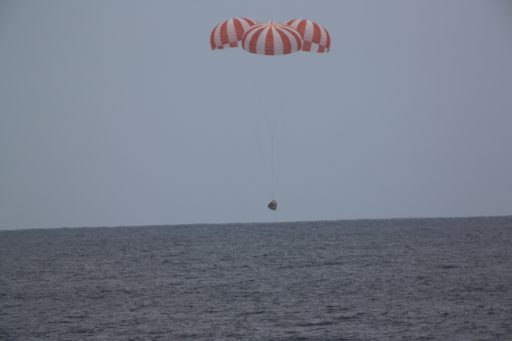
The SpaceX Dragon made a successful return from a month-long Space Station Mission on Wednesday, splashing down in the Pacific Ocean at 18:51 UTC several hours after the spacecraft was detached from the International Space Station to begin its homebound journey.
Landing marks the start of a race against the clock as precious science cargo needs to be returned to shore for laboratory analysis.
The SpX-8 mission was Dragon’s comeback after the Falcon 9 launch failure that claimed the loss of the SpX-7 spacecraft in June 2015, leading to a multi-month stand-down of Falcon 9 missions causing subsequent Dragon missions to slip as well. For the first time launching atop the Full Thrust version of the Falcon 9, Dragon enjoyed a smooth trip into orbit on April 8 while the Falcon 9 booster successfully made its way back to the Autonomous Spaceport Drone Ship becoming SpaceX’s first successful recovery at sea.
Captured by the Station’s robotic arm after a two-day link-up, Dragon was berthed to the Harmony module, taking a spot next to Orbital ATK’s Cygnus spacecraft, residing on the Earth-facing port of the Unity Node – providing the very first opportunity for a Commercial Resupply Services family portrait in orbit with both craft present at ISS. Riding aboard the Dragon were 3,136 Kilograms of hardware, science and supplies for ISS.
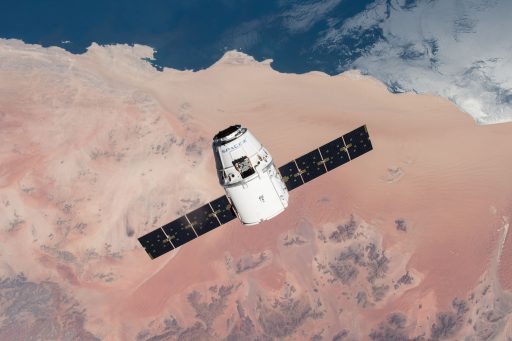
Delivered inside Dragon’s Trunk Section was the Bigelow Expandable Activity Module, setting out on a demonstration mission of expandable habitat technology that may build the foundation for deep space travel. Installed by the Station’s robotic arm on April 16, BEAM will be inflated around May 25 followed by the installation of sensors to track how the module fares during a two-year stay in space.
Also aboard Dragon was a group of Mice for the third Rodent Habitat mission, studying a novel drug that may prevent bone and muscle loss in astronauts during extended space missions and mitigate the effects of muscle-wasting diseases on Earth. Dozens of other experiments were delivered by Dragon, some of which were performed while Dragon was berthed to ISS to return aboard the spacecraft, others will be in progress for longer durations.
Over the course of Dragon’s one-month stay, the crew moved cargo from the Dragon to ISS and loaded the spacecraft with over 1,650 Kilograms of return items including systems hardware awaited for inspections on the ground, personal crew items, and performed experiments and samples.
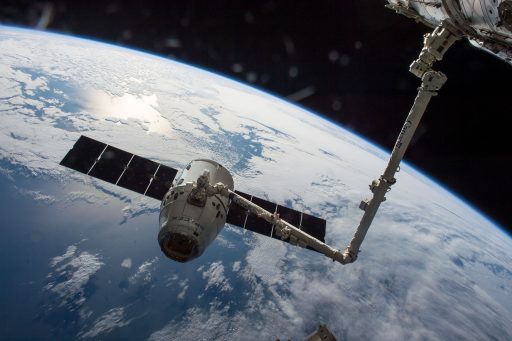
After nearly a year without a cargo return flight, the laboratory freezers aboard ISS were filled with plenty of samples collected by the astronauts over the course of their missions to track how the different bodily systems respond to the microgravity and radiation environment in space.
Loaded into freezers on Dragon and placed in Double Cold Bags, these samples make up the most valuable part of Dragon’s return cargo. The majority of samples from Scott Kelly’s One-Year Expedition and the Twins Study involving his brother Mark were returned aboard the Dragon and are eagerly awaited by several institutions for analysis as part of dozens of studies.
Also loaded into Dragon for return was a complete Space Suit, Extravehicular Mobility Unit #3011 that has a storied history after several years aboard ISS. The suit was worn by Luca Parmitano in the July 2013 spacewalk that had to be terminated when a considerable water leak placed Parmitano in a sticky situation with water accumulating around his head. He and fellow EV crew member Chris Cassidy reached the safety of the airlock just in time, leading to an exhaustive investigation into the circumstances of the dangerous water leak.
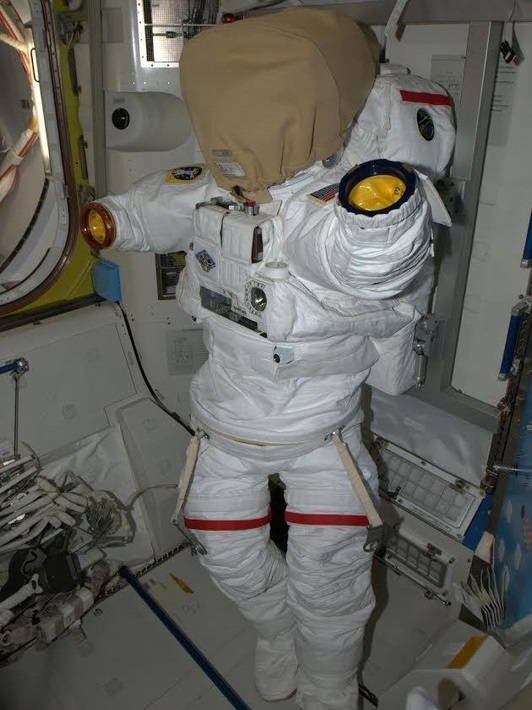
The investigation quickly zeroed in on the now infamous Fan-Pump Separator, a critical component of the suit’s thermal and life support systems. Since the 2013 spacewalk there have been several failures involving Fan Pump Separators during test runs aboard ISS involving different space suits and replacement components flown up to ISS. On the most recent EVA of 3011, Astronaut Tim Kopra reported a small water leak, prompting NASA to take the suit out of rotation and conduct an in-depth inspection on the ground.
Being closed out for its return, Dragon was readied for its home-bound trip that began in the morning hours on Wednesday with the demating of the spacecraft from the Harmony module followed by a maneuver of Canadarm2 to position the vehicle for release. ESA Astronaut Time Peake released the Dragon at 13:19 UTC and three departure burns placed the spacecraft on a safe trajectory away from ISS for a free flight of three orbits.
Performing its three-orbit free flight, Dragon completed the final reconfigurations ahead of its re-entry, including the closure of the GNC Bay Door to protect the navigation sensors used during the rendezvous with ISS from the harsh environment of re-entry.
The Dragon began is ten-minute deorbit burn at 18:01 UTC, firing a subset of its Draco thrusters, each delivering 400 Newtons of thrust. Holding a retrograde attitude, Dragon slowed down by about 100 meters per second, placing it on a trajectory to intercept Earth’s dense atmosphere at a precisely targeted location from where Dragon could reach the desired parachute opening location.
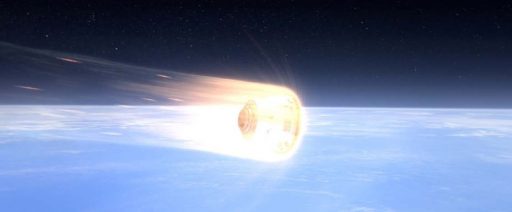
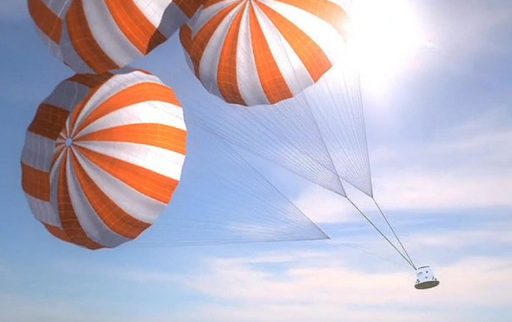
The Trunk Section was separated around 18:18 UTC, sending the vehicle’s solar arrays and aft cargo carrier toward a fiery demise. Dragon itself hit the atmosphere around 18:30 UTC with its heat shield facing the direction of travel as temperatures ramped up to 1,600°C. Throughout the Entry Phase, Dragon stabilized itself using its Draco thrusters.
While entry was in progress, Dragon constantly computed its trajectory, using data from the vehicle’s GPS System and Inertial Measurement Units to adjust the vehicle’s orientation to control the lift generated by the capsule to precisely target its desired splashdown zone. Slowing down in the dense atmosphere, Dragon reached a speed of 240 meters per second when the Drogue Parachutes were commanded to deploy at an altitude of 13.7 Kilometers. The three main chutes were released at an altitude of around three Kilometers, opening in an initial reefing stage before being fully opened to transition Dragon to a vertical descent and slow it down to 20 Kilometers per hour.
Splashdown – confirmed through SpaceX’s Twitter Account – occurred on time at 18:51 UTC in the designated landing area around 400 Kilometers off the Californian coast line. SpaceX recovery forces had been deployed to the Landing Zone well in advance of splashdown and teams were able to track the Dragon in the final stages of its descent.
Immediately after Dragon’s splashdown, recovery teams started making their way to the floating vehicle. Fast boasts were planned to be arriving at the spacecraft shortly after landing so that technicians could complete the initial safing of the craft in the water and attach a harness to the vehicle that will be used to pull the craft out of the Ocean and place it in a cradle aboard the recovery ship. Aboard the ship, Dragon will undergo safing operations and be placed on external power to keep up the cold chain required by the samples inside the lab freezers.
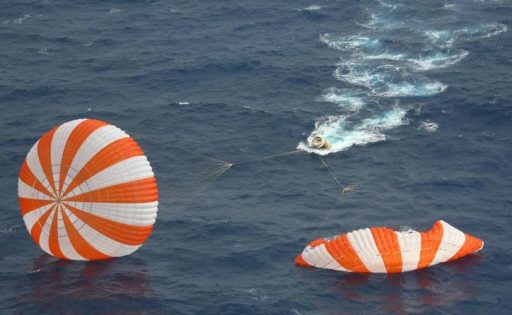
Dragon’s successful landing marks the beginning of a race against the clock as payloads returned in Double Cold Bags need to be delivered to their respective operators within 48 hours of landing – giving SpaceX around 25 to 26 hours to make the trip back to port. The time-critical samples and experiment materials will be flown back to Houston as soon as they arrive on shore, using the Port of Long Beach. The rest of the cargo will be unloaded once Dragon is back at SpaceX’s Texas site for return to NASA over the coming days.
The next Dragon mission is currently aiming for launch in late June and will carry to ISS an International Docking Adapter (IDA) needed to make the Station’s docking ports fit for the start of Commercial Crew Traffic. The first IDA was lost in the SpX-7 failure making the next mission critical for the on-time start of Commercial Crew flights to ISS.
For the crew aboard ISS, operations will continue full speed ahead for the coming weeks with Cygnus set for departure on June 2 and plenty of cargo work still to be done. Operations as part of Expedition 47 will wind down for the return to Earth of Soyuz TMA-19M with Yuri Malenchenko, Tim Peake and Tim Kopra on June 18 followed less than a week later by the launch of Soyuz MS-01 with the Expedition 48/49 crew of Anatoly Ivanishin, Takuya Onishi and Kate Rubins.

